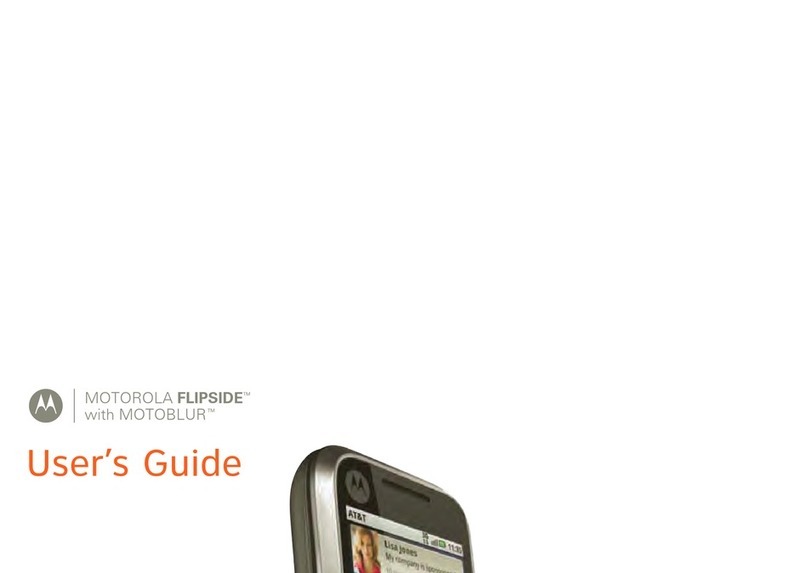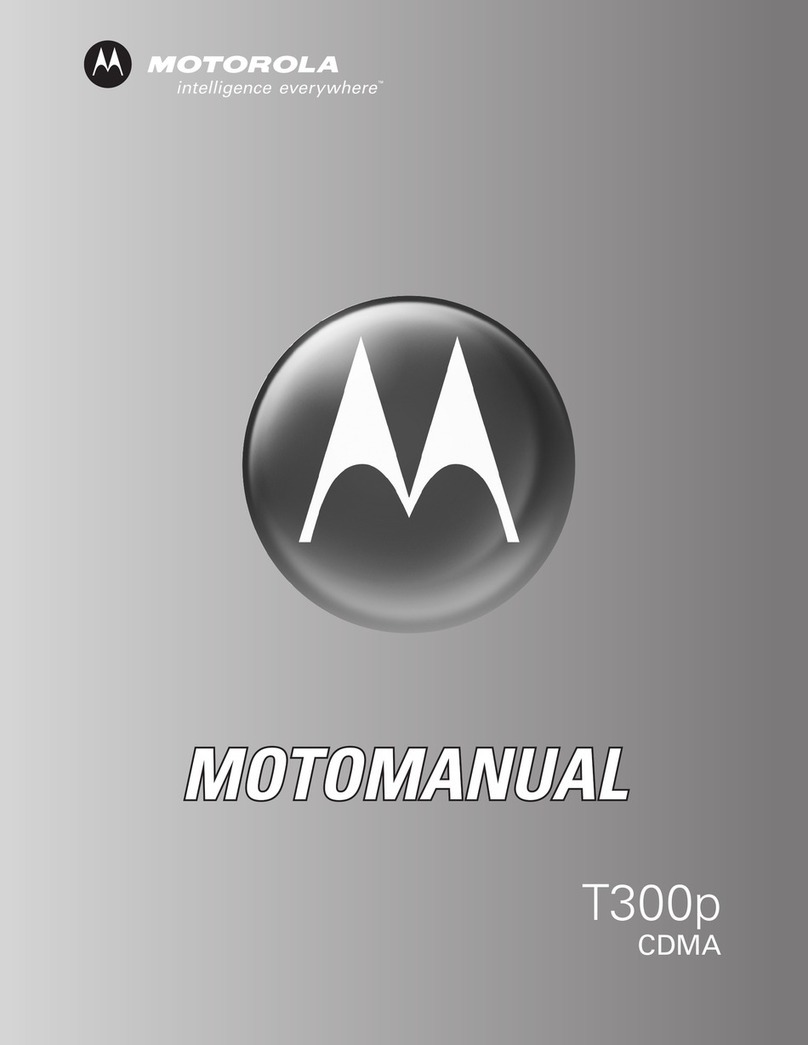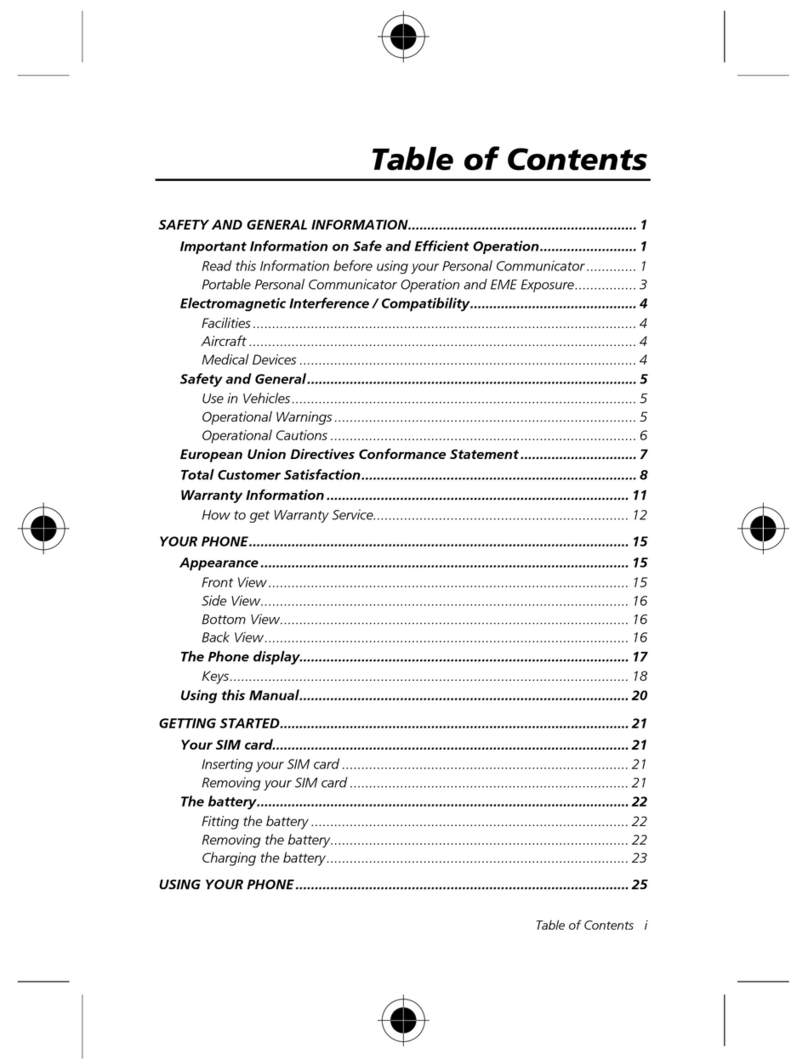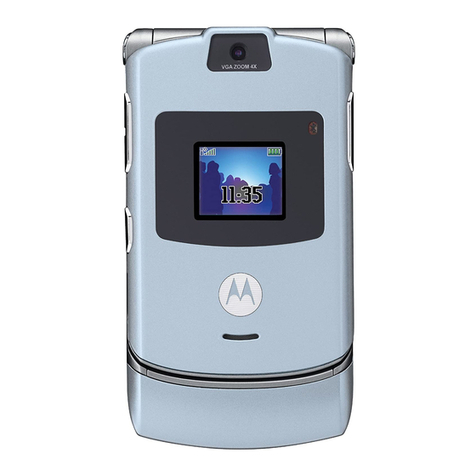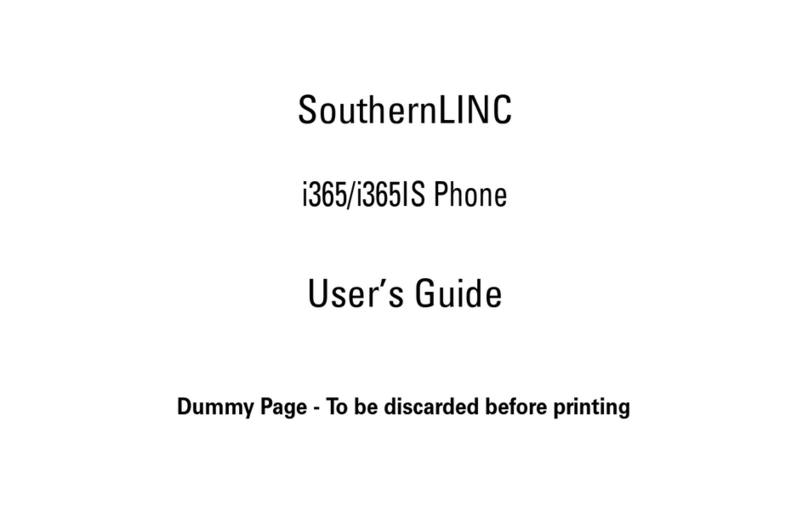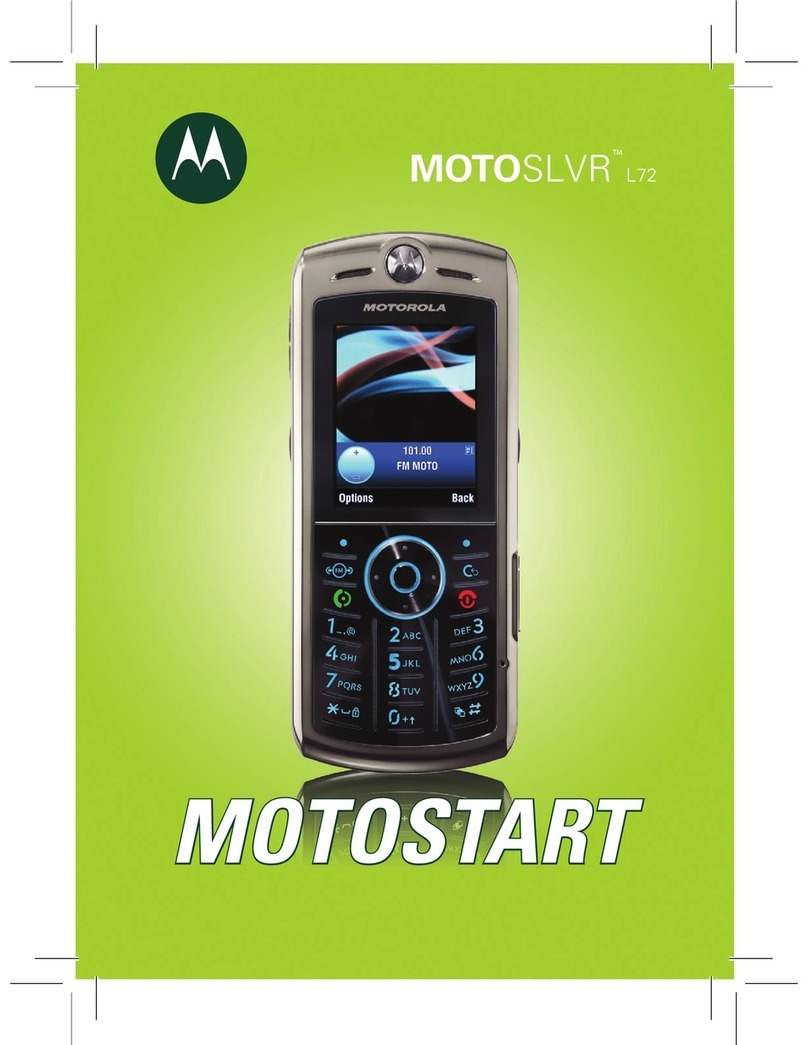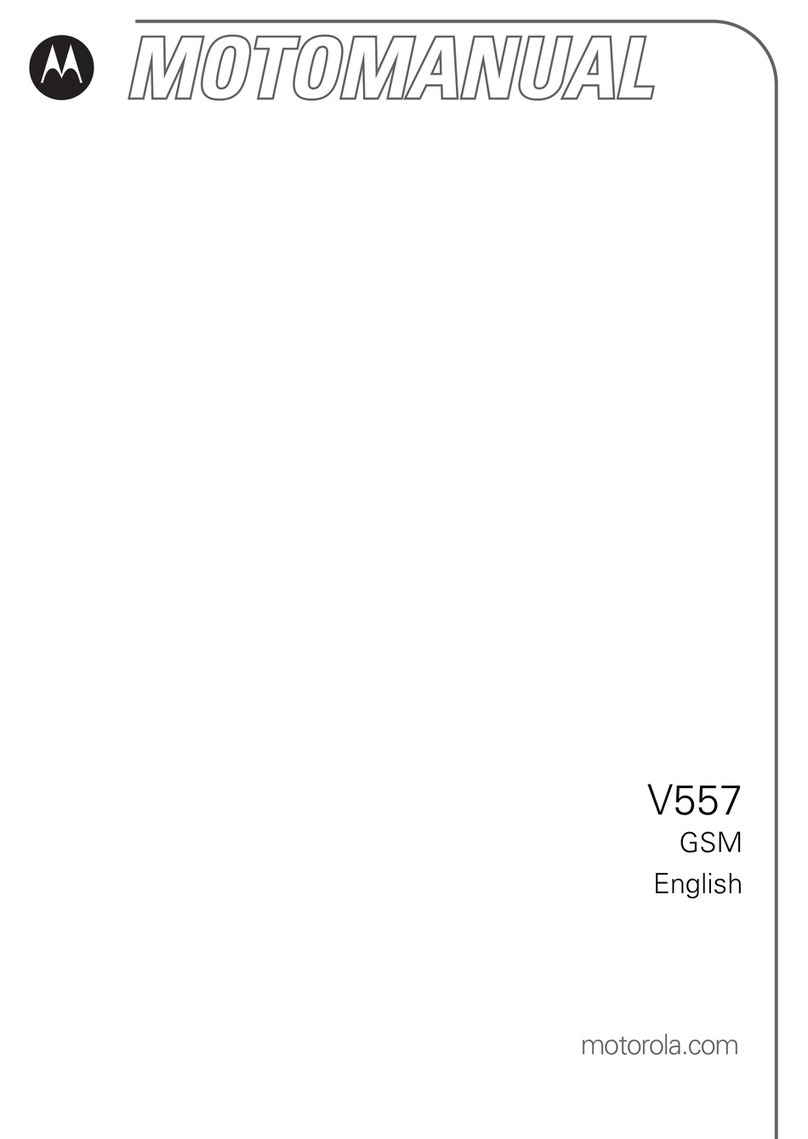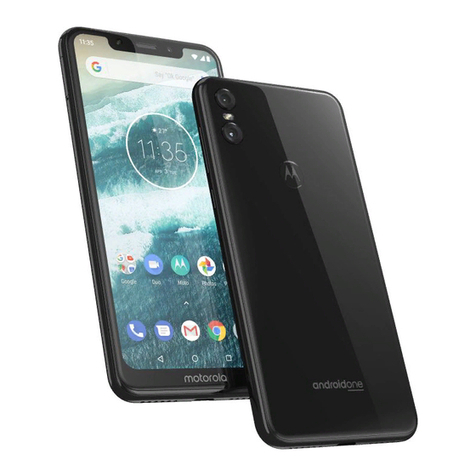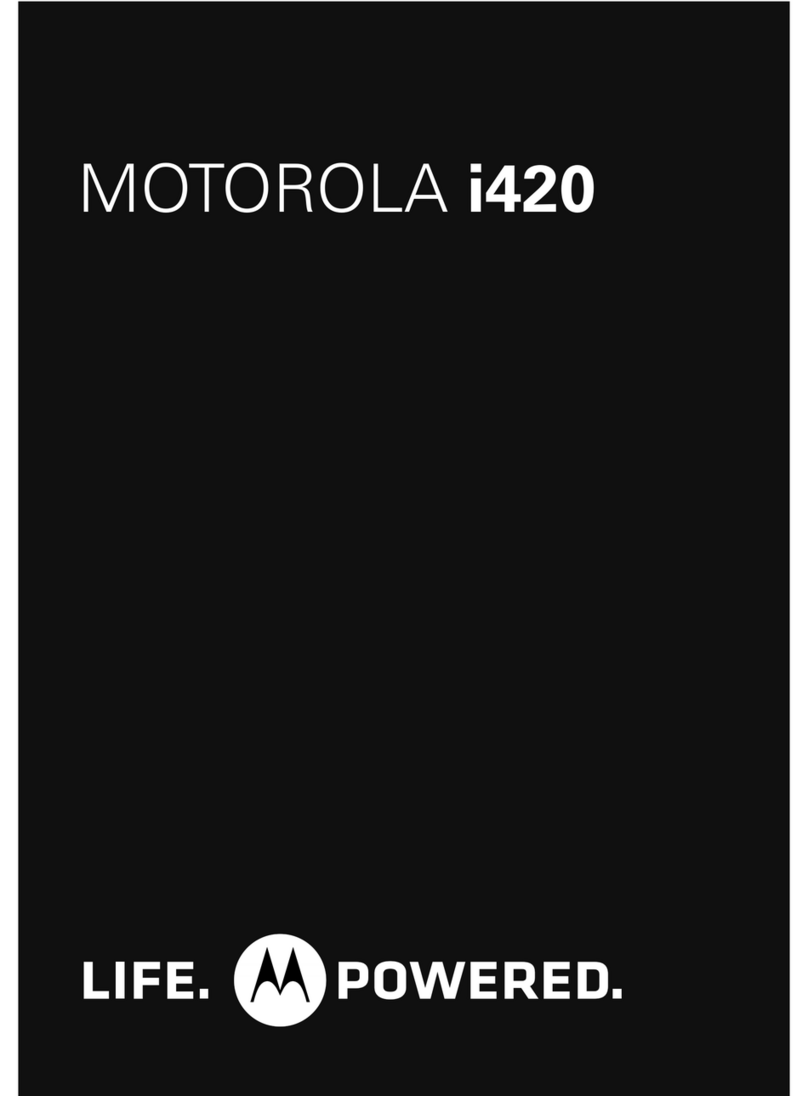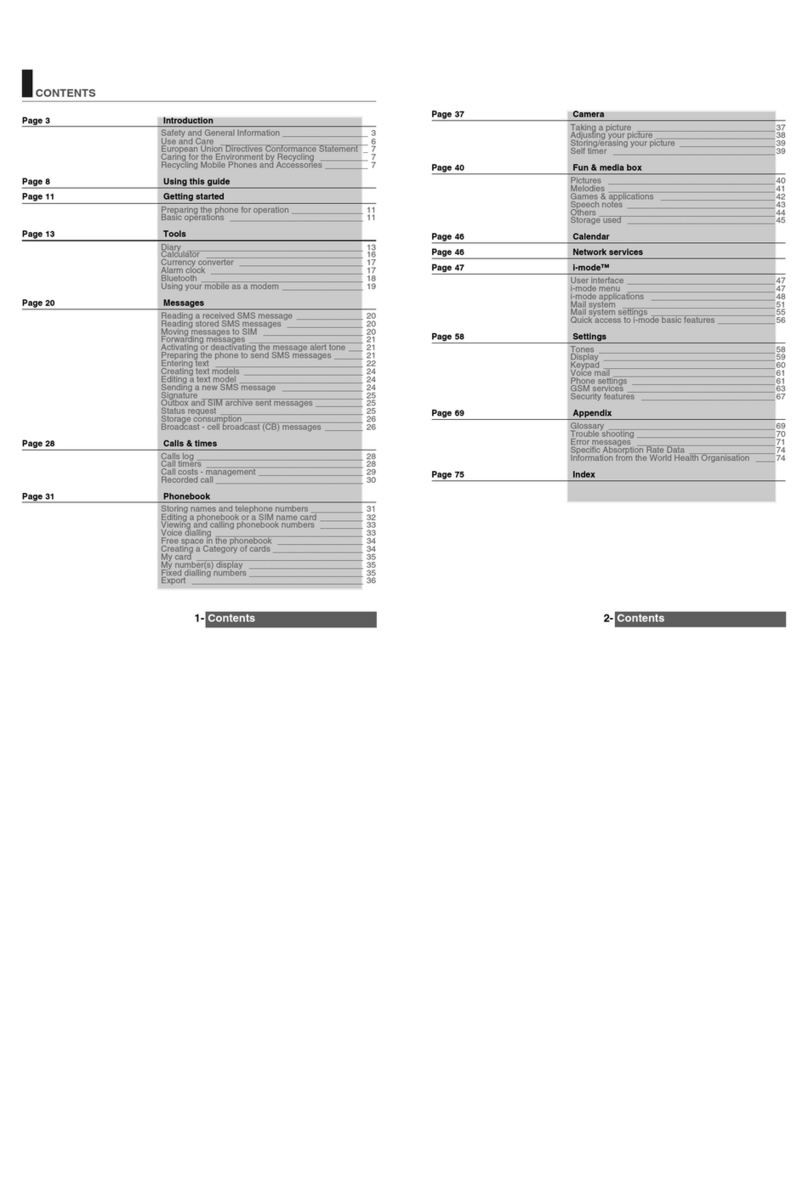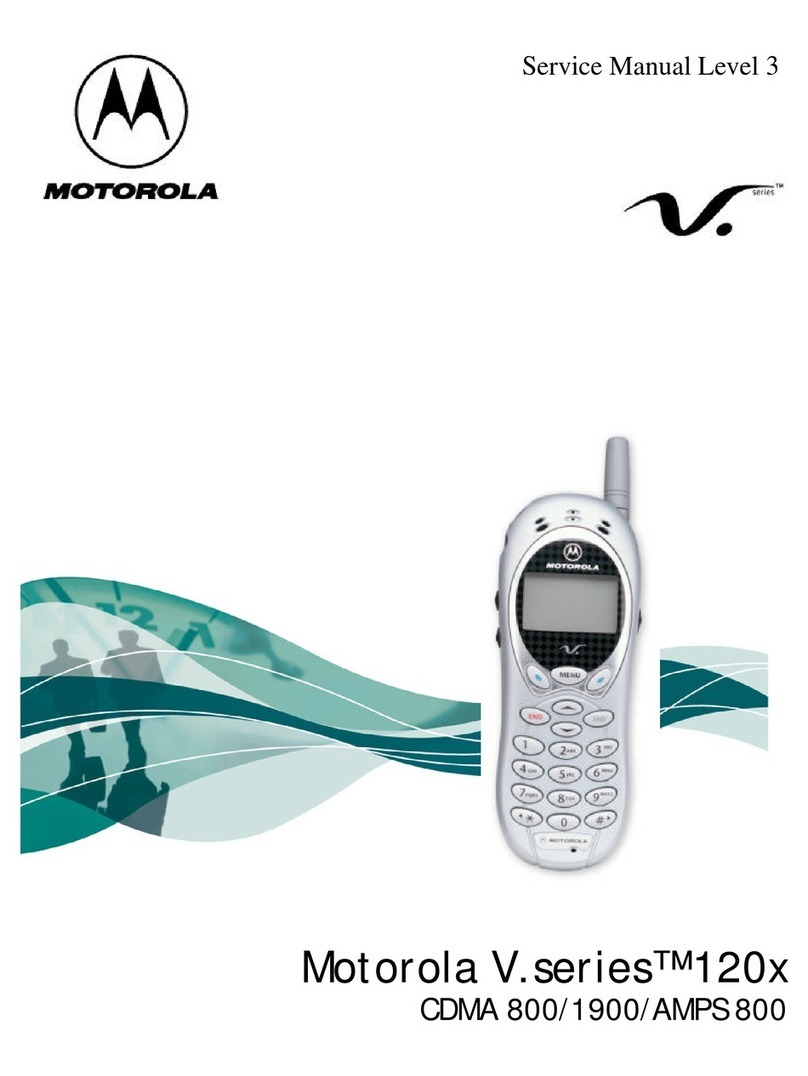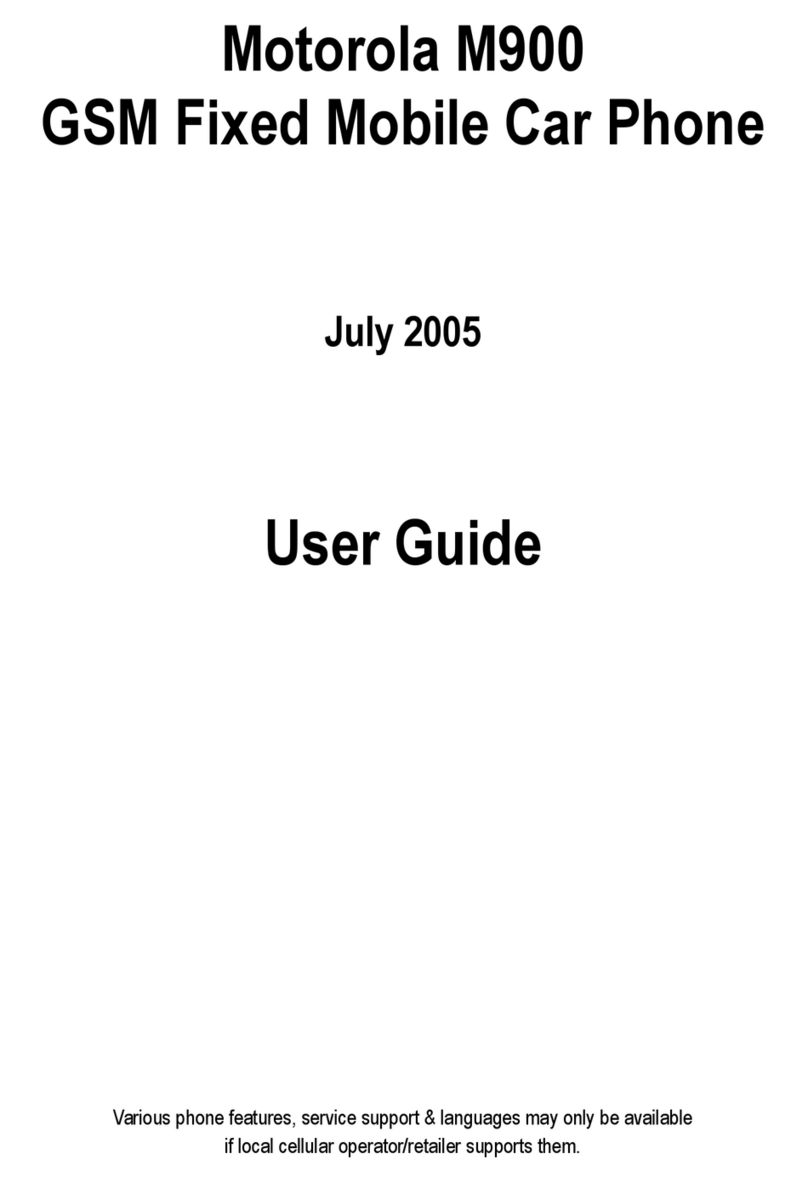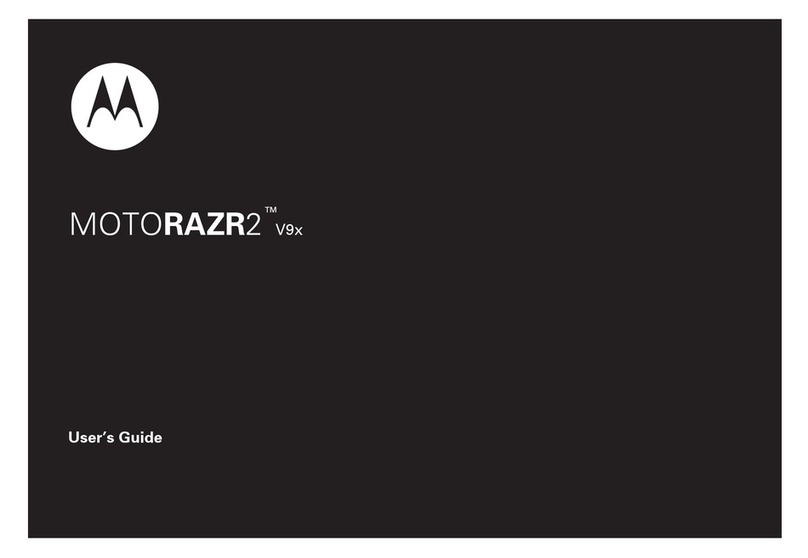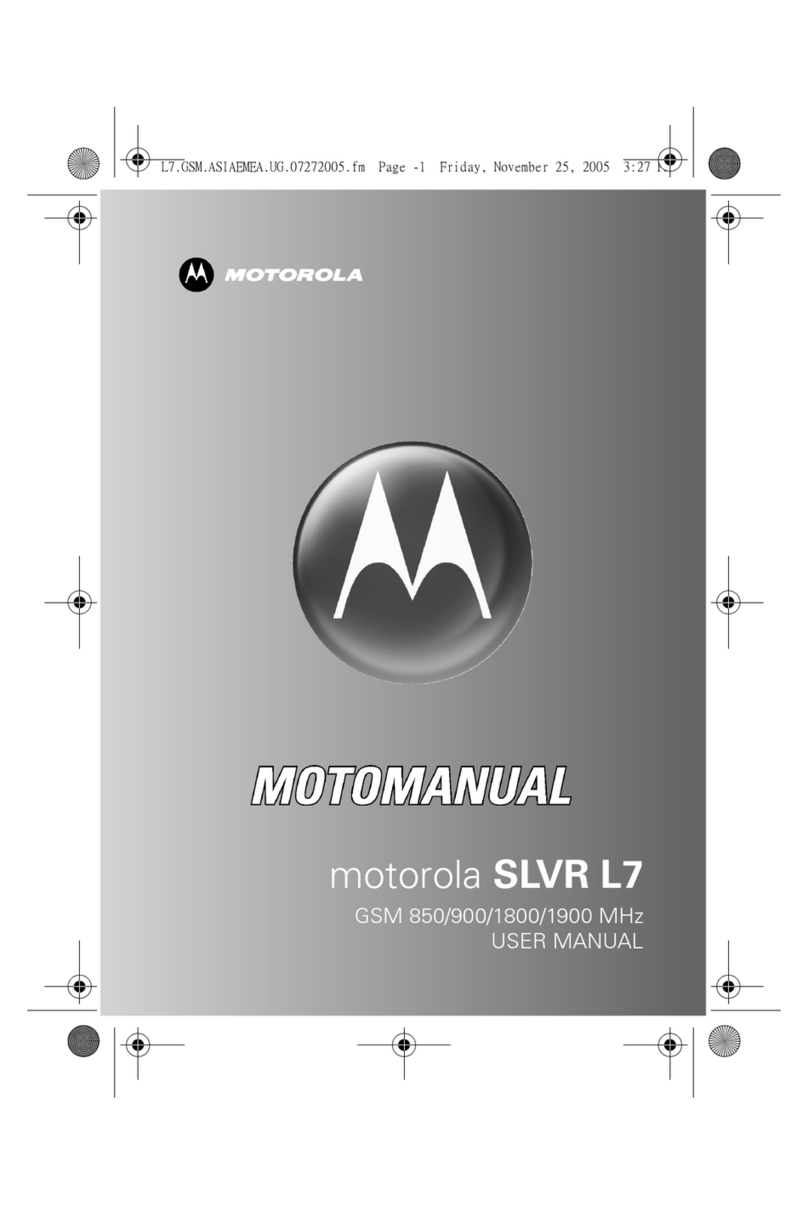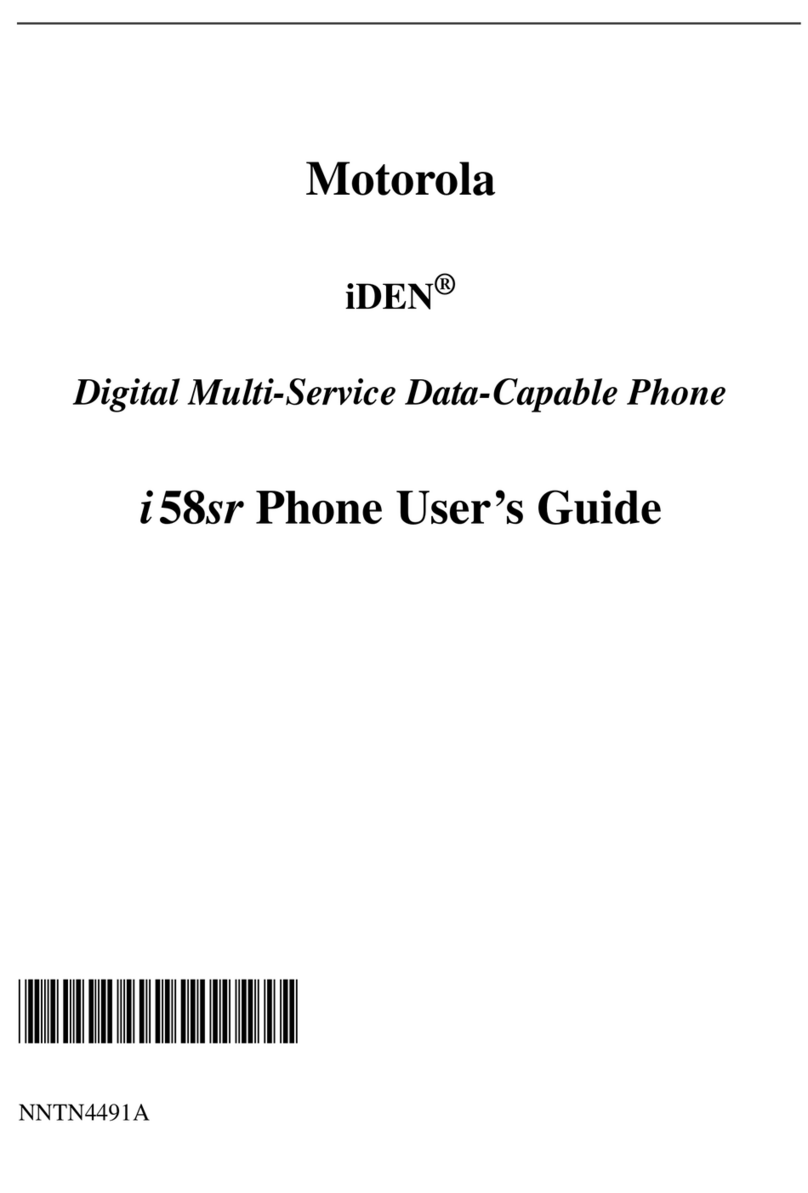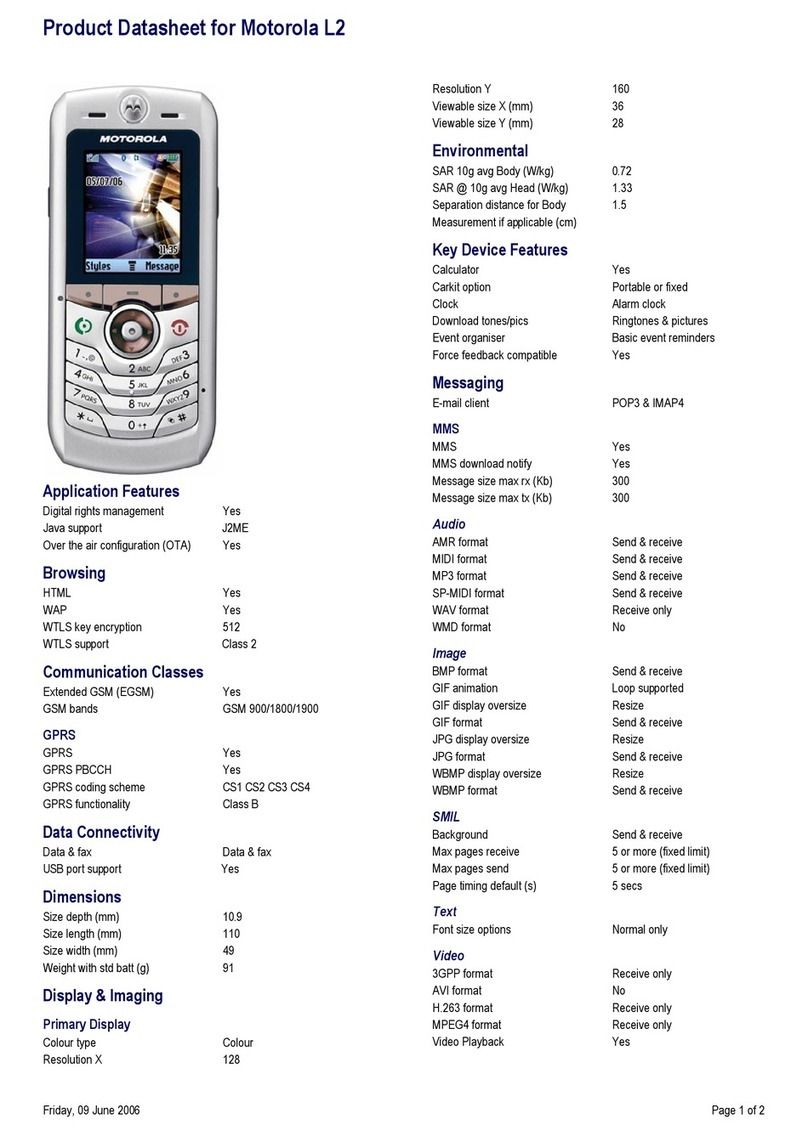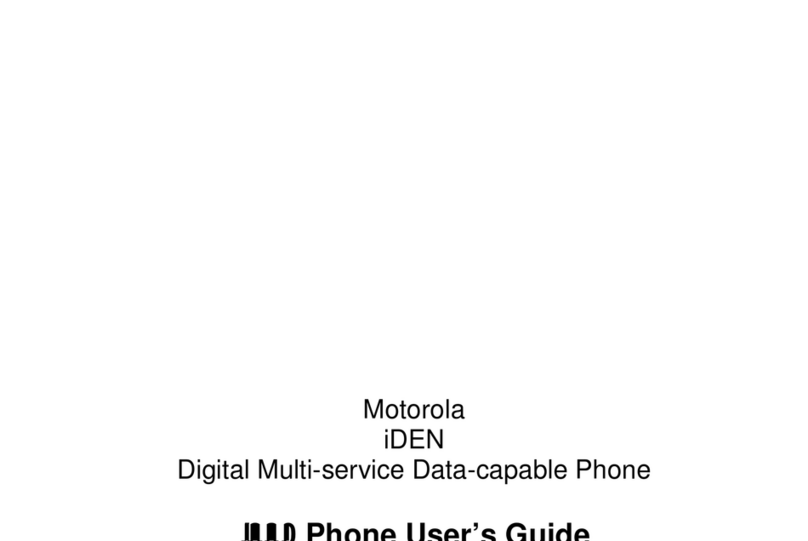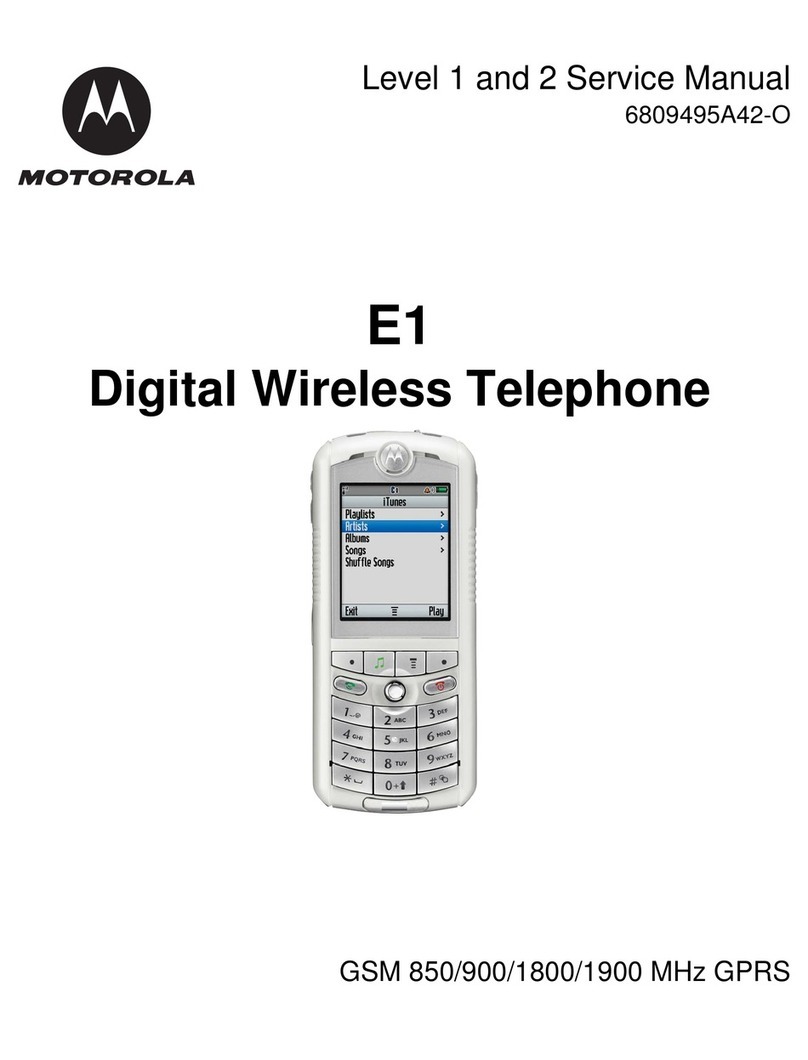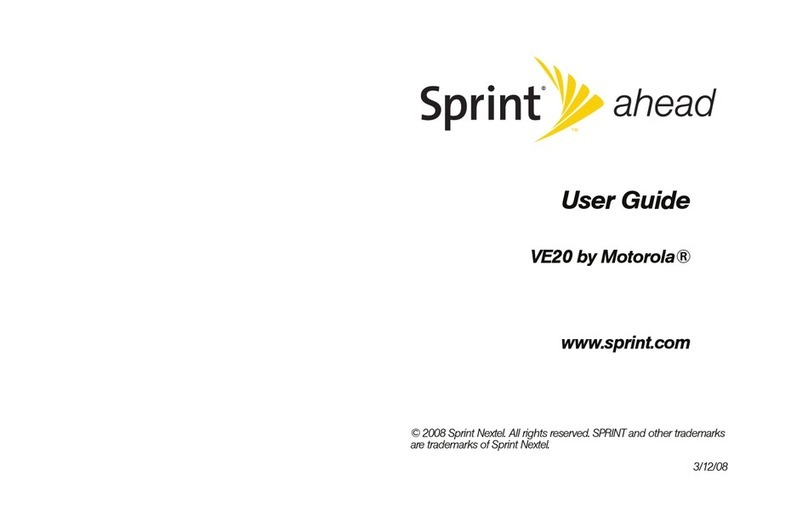
Safety,Regulatory&Legal
Battery Use & Safety
Battery Use & Safety
Important: Handle and store batteries properly to avoid injury or damage.
Most battery issues arise from improper handling of batteries, and particularly
from the continued use of damaged batteries.
DON’Ts
• Don’t disassemble, crus h, puncture, shred , or otherwise a ttempt to
change the form of your battery.
• Don’t let the mobile device or battery come in contact with liquids.*
Liquids can get into the mobile device’s circuits, leading to corrosion.
• Don’t allow the battery to touch metal objects.
If metal objects, such as
jewelry, stay in prolonged contact with the battery contact points, the
battery could become very hot.
•Don’tplace your mobile device or battery near a heat source.*
High
temperatures can cause the battery to swell, leak, or malfunction.
• Don’t dry a wet or dampbattery with an appliance or heat source
, such
as a hair dryer or microwave oven.
DOs
• Do avoid leaving your mobile device in your car in high temperatures.*
• Do avoid dropping the mobile device or batter y.*
Dropping these items,
especially on a hard surface, can potentially cause damage.*
•Docontact your service provider or Motorola if your mobile device or
battery has been damaged by dropping, liquids or hi gh temperatures.
*Note:
Always make sure that the battery compartment and any connector
covers are closed and secure to avoid direct exposure of the battery to any of
these conditions, even if your product information states that your
mobile
device
can resist da mage from the se conditions.
Important: Motorola recommends you always use Motorola-branded
batteries and chargers for quality as surance and safeguards.
Motorola’s
warranty does not cover damage to the mobile device caused by non-Motorola
batteriesand/or chargers. To help you identify authenticMotorola batteries from
non-original or counterfeit batteries (that may not have adequate safety
protection), Motorola provides holograms on its batteries. You should confirm
that any battery you purchase has a “Motorola Original” hologram.
If you see a message on your display such as
Invalid Battery
or
Unable to Charge
, take the following steps:
•
Remove the battery and inspect it to confirm that it has a
“Motorola Original” hologram;
•
If there is no hologram, the battery is not a Motorola battery;
•
If there is a hologram, replace the battery and try charging it again;
•
If the message remains, contact a Motorola authorized service center.
Warn ing :
Use of a non-Motorola battery or charger may present a risk of fire,
explosion, leakage, or other hazard.
Proper and safe battery disposal and recycling:
Proper battery disposal is not
only import ant for safety, it benefits the enviro nment. You can recycl e your used
batteries in many retail or service provider locations. Additional information on
proper disposal and recycling can be found at
www.motorola.com/
recycling
Disposal:
Promptly dispose of used batteries in accordance with local
regulations. Contact your local recycling center or national recycling
organizatio ns for more inform ation on how to dis pose of batteries.
Warn ing :
Never dispose of batteries in a fire because they may
explode.
Battery Charging
BatteryCharging
Notes for charging your product’s battery :
•
During charging, keep your battery and charger near room temperature for
efficient battery charging.
•
New batteries are not fully charged.
•
New batteries or batteries stored for a long time may take more time to
char ge.
•
Motorola batteries and charging systems have circuitry that protects the
battery from damage from overcharging.
Third Party Accessories
Use of third pa rty access ories, incl uding but not lim ited to batteries , chargers,
headsets, covers, cases, screen protectors and memory cards, may impact your
mobile device’s performance. In some circumstances, third party accessories
can be dangerous and may void your mobile device’s warranty. For a list of
Motorola accessories, visit
www.motorola.com/products
Driving Precautions
Responsible and safe driving is your primary responsibility when behind the
wheel of a vehicle. Using a mobile device or accessory for a call or other
application while driving may cause distraction. Using a mobile device or
accessory may be prohibited or restricted in certain areas, always obey the laws
and regulations on the use of these products.
While driving, NEVER:
•
Type or read texts.
•
Enter or review written data.
•
Surf the web.
•
Input naviga tion infor mation.
•
Perform any other functions that divert your attention from driving.
While driving, ALWAYS:
•
Keep your eyes on the road.
•
Use a handsfree device if available or required by law in your area.
•
Enter destination information into a navigation device
before
driving.
•
Use voice activated features (such as voice dial) and speaking features (such
as audible directions), if available.
•
Obey all local laws and regulations for the use of mobile devices and
accessories in the ve hicle.
•
End your call or other task if you cannot concentrate on driving.
Remember to follow the “Smart Practices While Driving” in this guide and at
www.motorola.com/callsmart
(in English on ly).
Seizures/Blackouts
Some people may be susce ptible to epilep tic seizures or bla ckouts when
exposed to flash ing lights, s uch as when playing vide os or games. These may
occur even if a person has never had a previous seizure or blackout.
If you have experienced seizures or blackouts, or if you have a family history of
such occurrences, please consult with your physician before playing videos or
games or enabling a flashing-lights feature (if available) on your mobile device.
Discontinue use and consult a physician if any of the following symptoms occur:
convulsion, eye or muscle twitching, loss of awareness, involuntary
movements, or disor ientation . It is always a good idea to hold th e screen away
from your eyes, leave the lights on in the room, take a 15-minute break every
hour, and stop use if you are tired.
Caution About High Volume Usage
Warning:
Exposure to loud noise from any sourcefor extended periods of time
may affect your hearing. The louder the volume sound level, the less time is
required before your hearing could be affected. To protect your hearing:
•
Limit the amount of time you use headsets or headphones at high volume.
•
Avoid turning up the volume to block out noisy surroundings.
•
Turn the volume down if you can’t hear people speaking near you.
If you experience hearing discomfort, including the sensation of pressure or
fullness in your ears, ringing in your ears, or muffled speech, you should stop
listening to the device through your headset or headphones and have your
hearing checked.
For more information about hearing, see our website at
direct.motorola.com/hellomoto/nss/Acoustic Safety.asp
(in
English only ).
Repetitive Motion
When you repeti tively perform act ions such as pressi ng keys or entering f inger-
written characters, you may experience occasional discomfort in your hands,
arms, shoulders, neck, or other parts of your body. If you continue to have
discomfort during or after such use, stop use and see a physician.
Children
Keepyour mobile device and its acces sories away from small children.
These products ar e not toys and may be hazardous to sma ll children. For
example:
•
A choking hazard may exist fo r small, deta chable parts.
•
Improper use could result in loud sounds, possibly causing hearing injury.
•
Improperly handled batteries could overheat and cause a burn.
Similar to a com puter, if a child does use your m obile device, yo u may want to
monitor their access to help prevent exposure to inappropriate apps or content.
Glass Parts
Some parts of your mobile device may be made of glass. This glass could break
if the product receives a substantial impact. If glass breaks, do not touch or
attempt to remove. Stop using your mobile device until the glass is replaced by
a qualified service center.
Operational Warnings
Obey all posted signs when using mobile devices in public areas.
Potentially Explosive Atmospheres
Areas with potentially explosive atmospheres are often, but not always, posted
and can include fueling areas, such as below decks on boats, fuel or chemical
transfer or storage facilities, or areas where the air contains chemicals or
particles, such as grain dust, or metal powders.
When you are in su ch an area, turn off your mobile dev ice, and do not r emove,
install, or charge batteri es unless it is a radio prod uct type especially q ualified for
use in such areas as “Intrinsically Safe” (for example, Factory Mutual, CSA, or
UL approved). In such areas, sparks can occur and cause an explosion or fire.
Symbol Key
Your battery, charger, or mobile device may contain sy mbols, defin ed as follows:
Radio Frequency (RF) Energy
Exposure to RF Energy
Your mobile device contains a transmitter and receiver. When it is ON, it receives
and transmits RF en ergy. When you communic ate with your mobil e device, the
system handling your call controls the power level at which your mobile device
transmits.
Your mobile device is designed to comply with l ocal regulatory requirements in
your countr y concerning ex posure of human be ings to RF energy.
RF Energy Operational Precautions
For optimal mobile device performance, and to be sure that human exposure to
RF energy does not exceed the guidelines set forth in the relevant standards,
always follow these instructions and precautions:
•
When placing or receiving a phone call, hold your mobile device just like you
would a landline phone.
•
If you wear the mobiledevice on your body, always place the mobile device in
a Motorola-supplied or approved clip, holder, holster, case, or body harness.
If you do not use a body-worn accessory supp lied or approved by Motorola,
keep the mobile device and its antenna at least 2.5 cm (1 inch) from your
body when transmitting.
•
Using accessories not supplied or approved by Motorola may cause your
mobile device to exceed RF energy exposure guidelines. For a list of
Motorola-supplied or approved accessories, visit our website at:
www.motorola.com
.
RF Energy Interference/Compatibility
Nearly every el ectronic device is subject t o RF energy inte rference from exter nal
sources if inadequately shielded, designed, or otherwise configured for RF
energy compatibility. In some circumstances, your mobile device may cause
interference with other devices.
Follow Instruction s to Avoid Interference Problems
Turn off your mobile device in any location where posted notices instruct you to
do so.
In an aircraft, turn o ff your mobile device wh enever instructed to d o so by airline
staff. If your mobile device offers an airplane mode or similar feature, consult
airline staff about using it in flight.
Implantable Medical Devi ces
If you have an implantable medical device, such as a pacemaker or defibrillator,
consult your physician before using this mobile device.
Persons with implantable medical devices should observe the following
precautions:
•
ALWAYS keep the mobile device more than 20 centimeters (8 inches) from
the implantable medical device when the mobile device is turned ON.
•
DO NOT carry the mobile device in the breast pocket.
•
Use the ear opposite the implantable medical device to minimize the
potential for interference.
•
Turn OFF the mobile device immediately if you have any reason to suspect
that interference is taking place.
Symbol Definition
Important safety information follows.
Do not dispose of your battery or mobile device in a fire.
Your battery or mobile device may re quire recycli ng in
accordance with local laws. Contact your local regulatory
authorities for more information.
Do not dispose of your battery or mobile device with your
household waste. See “Recycl ing” for more information.
Do not use tools.
For indoor use only.
Read and follow the directions from the manufacturer of your implantable
medical device. If you have any questions about using your mobile device with
your implantable medical device, consult your healthcare provider.
Specific Absorption Rate (ICNIRP)
SAR(ICN IRP)
YOUR MOBILE DEVICE MEETSINTERNATIONAL GUIDELINES FOR
EXPOSURE TO RADIO WAVES.
Your mobile device is a radio transm itter and receiver. It is design ed not to
exceed the limit s for exposure to ra dio waves (radio fre quency
electromagnetic fields) recommended by international guidelines. The
guidelines were developed by an independent scientific organization (ICNIRP)
and include a substantial safety margin designed to assure the safety of all
persons, regardless of age and health.
The radio wave exposure guidelines use a unit of measurement known as the
Specific Absorption Rate, or SAR. The SAR limit for mobile devices is 2 W/kg.
Tests for SAR are conducted using standard operating positions with the
device transmitting at its highest certified power level in all tested frequency
bands. The highes t SAR values under the ICN IRP guidelin es for your device
model are listed below:
During use, the actual SAR values for your device are usually well below the
values stated. This is because, for purposes of system efficiency and to
minimize interfer ence on the net work, the oper ating power of your mobi le
device is automatically decreased when full power is not needed for the call.
The lower the power output of the device, the lower its SAR value.
Body-worn SAR testing has been carried out using an approved accessory or
at a separation distance of 2.5 cm (1 inch). To meet RF exposure guidelines
during body-worn operation, the device should be in an approved accessory or
positioned at least 2.5 cm (1 inch) away from the body. If you are not using an
approved accessory, ensure that whatever product is used is free of any metal
and that it posit ions the phon e at least 2.5 cm (1 inch) away from th e body.
The World Health Organization has stated that present scientific information
does not indicate the need for any special precautions for the use of mobile
devices. They recomm end that if you are inte rested in furt her reducing you r
exposure then you can easily do so by limiting your usage or simply using a
hands-free kit to keep the device away from the head and body.
Additional information can be found at
www.who.int/emf
(World Health
Organization) or
www.motorola.com/rfhealth
(Motorola Mobility, Inc.).
Information from the World Health
Organization
WHOInfor mation
“A large number of studies have been performed over the last two decades to
assess whether mobile phones pose a potential health risk. To date, no
adverse health effects have been established for mobile phone use.”
Source: WHO Fact Sheet 193
Further information:
http://www.who.int/emf
European Union Directives
Conformance Statement
EUConformance
The following CE compliance information is applicable to Motorola mobile
devices that carry one of the following CE marks:
Hereby, Motorola declares that this product is in compliance with:
•
The essential requirements and other relevant provisions of Directive
1999/5/EC
•
All other relevant EU Directives
The above gives an example of a t ypical Product A pproval Number.
You can view your product’s Declaration of Conformity (DoC) to Directive 1999/
5/EC (to R&TTE Directive) at
www.motorola.com/r tte
. To find your DoC,
0168
[Only Indoor Use Allowed In France
for Bluetooth and/or Wi-Fi]
0168
0168
Product
Approval
Number
enter the Product Approval Number from your product’s label in the “Search”
bar on the websit e.
FCC Notice to Users
FCCNotice
The following statement applies to all products that bear the FCC logo on
the product label.
This equipment has been tested and found to comply with the limits for a Class
B digital device, pursuant to part 15 of the FCC Rules. See 47 CFR Sec.
15.105(b). These limits ar e designed to p rovide reasonab le protecti on against
harmful interference in a residential installation. This equipment generates,
uses and can radiate radio frequency energy and, if not installed and used in
accordance with the instructions, may cause harmful interference to radio
communications. However, there is no guarantee that interference will not
occur in a particular installation. If this equipment does cause harmful
interference to radio or television reception, which can be determined by
turning the equipment off and on, the user i s encouraged to try to co rrect the
interference by one or more of the following measures:
•
Reorient or relocate the receiving antenna.
•
Increase the separation between the equipment and the receiver.
•
Connect the equipment to an outlet on a circuit different from that to which
the receiver is connected.
•
Consult the dealer or an experienced radio/TV technician for help.
This device comp lies with part 15 of the FC C Rules. Operat ion is subject t o the
following two conditions: (1) This device may not cause harmful interference,
and (2) this device must accept any interference received, including
interference t hat may cause unde sired operat ion. See 47 CF R Sec. 15.19(a)(3).
Motorola has not approved any changes or modifications to this device by the
user. Any changes or modifications could void the user’s authority to operate
the equipment. See 47 CFR Sec. 15.21.
For products that suppo rt W-Fi 802.11a (as de fined in the product specif ications
available at
www.motorola.com
), the following information applies. This
equipment has the capability to operate Wi- Fi in the 5 GHz Unlicensed National
Information Infrastructure (U-NII) band. Because this band is shared with MSS
(Mobile Satellite Servic e), the FCC has restricted such devices to indoor use
only (see 47 CFR 15.407(e)). Since wireless hot spots operating in this band
have the same restriction, outdoor services are not offered. Nevertheless,
please do not op erate this devi ce in Wi-Fi mod e when outdoor s.
Smart Practices While Driving
DrivingSafety
Check the laws and regulations on the use of mobile devices and their
accessories in the areas where you drive. Always obey them. The use of
these devices may be prohibited or restricted in cert ain areas—for
example, handsfree use only may be required. Go to
www.motorola.com/callsmart
(in English only) for more
information.
Your mobile device lets you commu nicate by voice an d data—almo st
anywhere, anytime, wherever wireless service is available and safe conditions
allow. When driving a car,dr iving is yourfir st responsibility.I fyou choose to use
your mobile device while driving, remember the following tips:
• Get to know your Motorola mobile device and its features such as
speed dial, redial and voice dial.
If available, these features help you to
place your call without taking your attention off the road.
• When available, use a handsfree device.
If possible, add an additional
layer of convenience to your mobile device with one of the many
Motorola Original handsfree accessories available today.
• Position your mobile device within easy reach.
Be able to access your
mobile device without removing your eyes from the road. If you receive an
incoming call at an inconvenient time, if possible, let your voicemail answer
it for you.
• Let the person you are speaking with know you are driving; if
necessary, suspend the call in heavy trafficor hazardous weather
conditions.
Rain, sleet, snow, ice, and even heavy traffic can be hazardous.
• Do not take notes or look upphone numbers while driving.
Jotting
down a “to do” list or going through your address book takes attention
away from your primary responsibility—driving safely.
• Dial sensibly and assess the traffic; if possible, place calls when your
car is not moving or before pulling into traffic.
If you must make a call
while moving, dial only a few numbers, check the road and your mirrors,
then continue.
• Do not engage in stressful or emotio nal conversations that may be
distracting.
Make people you are talking with aware you are driving and
suspend conversations that can divert your attention away from the road.
• Use your mobile device to call for help.
Dial 911 or other local emergency
number in the case of fire, traffic accident, or medical emergencies
(wherever wireless phone service is available).
• Use your mobile device to helpothers in emergencies.
If you see an
auto accident, crime in progress, or other serious emergency where lives
are in danger, call 911 or other local emergency number (wherever wireless
phone service is available), as you would want others to do for you.
• Call roadside assistance or a special non-emergency wirel ess
assistance number when necessary.
If you see a broken-down vehicle
posing no serious hazar d, a broken traffic signal, a minor traffic accident
where no one appears injured, or a vehicle you know to be stolen, call
roadside assistance or other special non-emergency wireless number
(wherever wireless phone service is available).
Privacy & Data Security
Privacy& Data Security
Motorola understands that privacy and data security are important to everyone.
Because some features of your mobile device may affect your privacy or data
security, please follow these recommendations to enhance protection of your
information:
• Monitor access
—Keep your mobile device with you and do not leave it
where others may have unmonitoredaccess. Use your device’s security and
lock features, where available.
•Keepsoftware upto date
—If Motorola or a software/application vendor
releases a patch or software fix for your mobile device that updates the
device’s security, install it as soon as possible.
•Secure Personal Information
—Your mobile device can store personal
information in various locations including your SIM card, memory card, and
phone memory. Be sure to remove or clear all personal information before
you recycle, return, or give away your device. You can also backup your
personal data to transfer to a new device.
Note:
For information on how to backupor wipe data from your mobile device, go to
www.motorola.com/support
• Online accounts
—Some mobile devices provide a Motorola online account
(such as MOTOBLUR). Go to your account for information on how to
manage the account, and how to use security features such as remote wipe
and device location (where available).
•Applications and updates
—Choose your apps and updates carefully, and
install from trusted sources only. Some apps can impact your phone’s
performance and/or have access to private information including account
details, call dat a, location details an d network resources.
• Wireless
—For mobile devices with Wi-Fi features, only connect to trusted
Wi-Fi networks. Also, when using your device as a hotspot(where available)
use network security. These precautions will help prevent unauthorized
access to your device.
•Location-based information
—Location-based information includes
information that can be used to determine the approximate location of a
mobile device. Mobile phones which are connected to a wireless network
transmit location-based information. Devices enabled with GPS or AGPS
technology also transmit location-based information. Additionally, if you use
applications that require location-based information (e.g. driving directions),
such applications transmi t location-based information. This location-b ased
information may be shared with third parties, including your wireless
service provider, applications providers, Motorola, and other third parties
providin g serv ices.
• Other information your device may transmit
—Your device may also
transmit testing and other diagnostic (including location-based) information,
and other non-personal information to Motorola or other third-party servers.
This information is used to help improve products and services offered by
Motorola.
If you have further qu estions regardi ng how the use of your mob ile device may
impact your privacy or data security, please contact Motorola at
, or contact your service provider.
Use & Care
Use&Care
To care for your Motorola mobile device, please observe the following:
liquids
Don’t expose your mobile device to water, rain, extreme humidity,
sweat, or other liquids. If it does get wet, don’t try to accelerate
drying wit h the use of an oven or d ryer, as this may damag e the
mobile device.
extreme heat or cold
Don’t store or use your mo bile device in te mperatures below - 10°C
(14°F) or above 60°C (140°F). Don’t recharge your mobile device in
temperatures below 0°C (32°F) or above 45°C (113°F).
microwaves
Don’t try to dry your mobile device in a microwave oven.
dust and dirt
Don’t expose your mobile device to dust, dirt, sand, food, or other
inappropriate materials.
cleaning solutions
To clean your mobile device, use only a dry soft cloth. Don’t use
alcohol or ot her cleaning s olutions.
shock and vibration
Don’t drop your mobile d evice.
protection
To help protect your mobile device, always make sure that the battery
compartment and any connector covers are closed and secure.
Recycling
Recycling
Mobile Devices & Accessories
Please do not dispo se of mobile devic es or electric al accessorie s (such
as chargers, headset s, or batteries) with your ho usehold waste, or i n a
fire. These item s should be dispos ed of in accordance with the nati onal
collection an d recycling schemes op erated by your loc al or regional
authority. Alternat ively, you may return unwanted mobile devices an d electrical
accessories to any Mo torola Approved Ser vice Center in your region. Det ails of
Motorola approved national recycling schemes, and further information on
Motorola recycling activities can be found at:
www.motorola.com/
recycling
Packaging & Product Guides
Product packaging an d product guide s should onl y be disposed of i n accordance
with national coll ection and re cycling require ments. Please c ontact your regi onal
authorities for more details.
Software Copyright Notice
SoftwareCopyrightNotice
Motorola produc ts may include copyri ghted Motorola an d third-party s oftware
stored in semi conductor memories or oth er media. Laws in the United S tates and
other countries preserve for Motorola and third-par ty software providers certain
exclusive rights for copyrighted software, such as the exclusive rights to distribute
or reproduce the c opyrighted software. Acco rdingly, any copyrighte d software
contained in Motorola products may not be modified, reverse-engineered,
distributed, or r eproduced i n any manner to the ext ent allowed by law.
Furthermore, the purchase of Motorola products shall not b e deemed to grant
either directly or by implication, estoppel, or otherwise, any license under the
copyrights, patents, or patent applications of Motorola or any third-part yso ftware
provider, except for the normal , non-exclusive, royalt y-free licen se to use that
arises by operat ion of law in the sa le of a product.
Content Copyright
ContentCopyright
The unauthorized co pying of co pyrighte d materials is contrar y to the provisions of
the Copyright Laws of th e United Stat es and other count ries. This device i s
intended solely for copying non-copyrighted materials, materials in which you
own the copyright, or materials which you are authorized or legally permitted to
copy. If you are uncertain ab out your right to co py any material, pl ease contact
your legal advisor.
Copyright & Trademarks
Motorola Mobility, Inc.
852-25063888 (HK)
www.motorola.com/hk
(HK)
Certain feature s, services and ap plications are networ k dependent and may not
be available in all areas; additional terms, conditions and/or charges may apply.
Contact your ser vice provider for details.
All features, functiona lity, and other product spe cifications , as well as the
information contained in this guide, are based upon the latest available
information and believed to be accurate at the time of printing. Motorola
reserves the right to change or modify any information or specificat ions without
notice or obli gation.
Note:
The images in this guideare examples only.
MOTOROLA and the Stylized M Logo are trademarks or registered trademarks
of Motorola Trademark Holdings, LLC. All other product or service names are
the property of their re spective owners.
© 2011 Motorola Mobility, Inc. All rights reserved.
Caution:
Motorola does not take responsibility for changes/modification to the
transceiver.
Product ID: Motorola EX232
Manual Number: 68016144001
Safety, Regulatory & Legal
ENHK_68016144001.fm Page 2 Monday, May 23, 2011 3:31 PM
Head SAR GSM 0.753 W/kg
Body-worn SAR GSM 0.457 W/kg

